Environmentally Friendly Cars Now Used at the Airport and Port
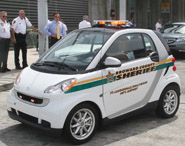 The Broward County Sheriff's Office integrated cost effective and environmentally sound smart cars into airport and port patrols. BSO used four, Smart “fortwo” coupes as patrol cars at the two facilities. The environmentally-friendly vehicles consume about one-sixth the fuel of a full-sized patrol car while idling, and are expected to incur less maintenance and operating costs. They are also very maneuverable in heavily congested areas like the airport and seaport .
The Broward County Sheriff's Office integrated cost effective and environmentally sound smart cars into airport and port patrols. BSO used four, Smart “fortwo” coupes as patrol cars at the two facilities. The environmentally-friendly vehicles consume about one-sixth the fuel of a full-sized patrol car while idling, and are expected to incur less maintenance and operating costs. They are also very maneuverable in heavily congested areas like the airport and seaport .
Photo At Right: One of the Smart coupes now visible at the airport and port.
County Encourages Use of Public Transportation to Reduce Carbon Footprint
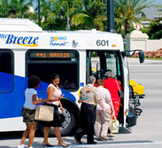 Public transportation in Broward County has grown much faster than the population. In 1997, the County’s population was 1,506,376. By 2007, it was 1,765,707, an increase of 17.2 percent or an average 1.56 percent per year. Broward County Transit's annual passenger trips increased from 25.1 million in 1997 to 39.2 million in 2007, an increase of 56 percent or an average 5 percent per year. The operation increased from 202 buses and 36 weekday routes in 1997 to 289 buses and 43 weekday routes in 2007. The largest growth in transit ridership occurred between 1999 and 2005, when increased funding to the transit system resulted in major system and service enhancements, including more buses, more frequent service during peak times, and additional and extended routes. BCT buses operate regionally in Southeast Florida with connections to Palm Beach and Miami-Dade county transit systems and Tri-Rail.
Public transportation in Broward County has grown much faster than the population. In 1997, the County’s population was 1,506,376. By 2007, it was 1,765,707, an increase of 17.2 percent or an average 1.56 percent per year. Broward County Transit's annual passenger trips increased from 25.1 million in 1997 to 39.2 million in 2007, an increase of 56 percent or an average 5 percent per year. The operation increased from 202 buses and 36 weekday routes in 1997 to 289 buses and 43 weekday routes in 2007. The largest growth in transit ridership occurred between 1999 and 2005, when increased funding to the transit system resulted in major system and service enhancements, including more buses, more frequent service during peak times, and additional and extended routes. BCT buses operate regionally in Southeast Florida with connections to Palm Beach and Miami-Dade county transit systems and Tri-Rail.
Partnership With Cities Enhances Community Bus Service
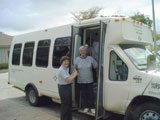 The County provides capital and operating assistance to 22 municipalities for Community Bus Service. Community bus vehicles are wheelchair accessible and because they are smaller than Broward County Transit buses, they are able to provide better access to city neighborhoods and services. Increased participation in the community bus service means fewer single passenger vehicle trips, shorter trips, better connections to neighboring cities and increased connections to traditional fixed bus routes.
The County provides capital and operating assistance to 22 municipalities for Community Bus Service. Community bus vehicles are wheelchair accessible and because they are smaller than Broward County Transit buses, they are able to provide better access to city neighborhoods and services. Increased participation in the community bus service means fewer single passenger vehicle trips, shorter trips, better connections to neighboring cities and increased connections to traditional fixed bus routes.
Annual ridership has increased an average of 37 percent per year since 1997, from 504,858 to 2,396,195 annual passengers. Participating cities are Coconut Creek, Cooper City, Coral Springs, Dania Beach, Davie, Deerfield Beach, Fort Lauderdale, Hallandale Beach, Hillsboro Beach, Lauderdale-By-The-Sea, Lauderdale Lakes, Lauderhill, Lighthouse Point, Margate, Miramar, North Lauderdale, Oakland Park, Pembroke Pines, Plantation, Pompano Beach, Tamarac and Wilton Manors.
Alternative Fuel Vehicle Program Reduces Greenhouse Gases
Since 1997, Broward County has taken many voluntary actions to reduce greenhouse gases. These actions have resulted in 62,491 fewer tons of greenhouse gas emissions, equivalent to the emissions from 11,450 cars. Contributing to this reduction are an alternative fuel and advanced technology vehicle program, in place since 1988. In the County fleet, there are:
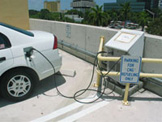 51 hybrid-electric vehicles
51 hybrid-electric vehicles- 47 bi-fuel compressed natural gas/gasoline (CNG) vehicles
- 13 CNG vehicles and five CNG refueling sites
- 8 liquified petroleum vehicles (LPG) and one LPG refueling site
- one electric vehicle
The County’s Fleet Services Division introduced biodiesel fuels, beginning in 2007 and has dispensed 173,330 gallons in County vehicles. The 20 percent blend (B20) does not require any alterations for diesel engines.
Broward County Transit transitioned from the use of low sulfur diesel fuel for its fleet operations to ultra low sulfur diesel fuel (ULSD). Fuel costs increased as a result of the conversion; however, there were environmental benefits. In addition, 42 replacement buses with newer pollution control technology are being incorporated into BCT's fleet. According to the U.S. EPA, these newer technology engines, when combined with the use of ULSD, will be up to 95 percent cleaner than previous models.
Fleet Services is testing the Hydro-4000, also known as a hydrogen cell, on a county vehicle. The Hydro-4000 is a device designed to save fuel, improve engine performance and provide a "green" alternative to conventional fuels like gasoline, ethanol and diesel.
County Adopts Aggressive Approach to Tire Maintenance
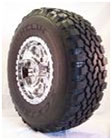 Fleet Services Division implements a four-pronged approach to tire maintenance: recapping, maintenance of optimal tire pressure, proper tire disposal and tire replacement only as needed. This approach saves money, reduces waste and fuel consumption, and reduces greenhouse gas emissions. The Division also enforces an aggressive tire recapping policy on heavy equipment, impacting approximately 75 tires per year.
Fleet Services Division implements a four-pronged approach to tire maintenance: recapping, maintenance of optimal tire pressure, proper tire disposal and tire replacement only as needed. This approach saves money, reduces waste and fuel consumption, and reduces greenhouse gas emissions. The Division also enforces an aggressive tire recapping policy on heavy equipment, impacting approximately 75 tires per year.
BCT Fleet Includes More Fuel Efficient Buses
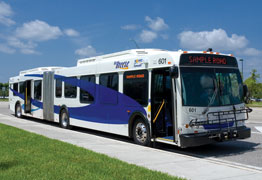 The growing Broward County Transit (BCT) fleet includes 12 hybrid-diesel/electric buses. The new buses are quieter than conventional buses, and expected to get 20 to 30 percent better fuel economy. They are also cleaner and emit 50 to 70 percent less hazardous air pollutants (particulate matter), fewer greenhouse gases, and less ozone (smog) forming pollutants. Because they operate cleaner by utilizing regenerative braking power, the new vehicles are also expected to have longer engine and brake life, and require less maintenance.
The growing Broward County Transit (BCT) fleet includes 12 hybrid-diesel/electric buses. The new buses are quieter than conventional buses, and expected to get 20 to 30 percent better fuel economy. They are also cleaner and emit 50 to 70 percent less hazardous air pollutants (particulate matter), fewer greenhouse gases, and less ozone (smog) forming pollutants. Because they operate cleaner by utilizing regenerative braking power, the new vehicles are also expected to have longer engine and brake life, and require less maintenance.
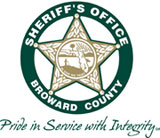
Broward Sheriff's Office Uses Synthetic Fuels
Thirty-five Fire/Rescue vehicles in the Broward Sheriff's Office fleet utilize synthetic oil.
Airport Vehicle Programs Reduces Greenhouse Gas Emissions
Fort Lauderdale-Hollywood International Airport (FLL) transports passengers to and from the terminals, parking garages and consolidated rental car center on one of the largest fleets of biodiesel and hybrid-electric buses in the nation. Broward County Aviation Department’s agreement with the fleet operator, ShuttlePort, mandates the use of alternative fuels, thereby reducing emissions and airport dependency on fuel sources that emit high levels of greenhouse gases. The FLL fleet includes biodiesel vehicles and five hybrid-electric vehicles.
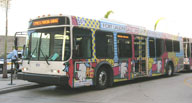 In 2006, airport management created General Transit Areas for ShuttlePort-operated biodiesel and hybrid-electric buses. During slow periods, buses are directed to this holding area where, weather permitting, drivers turn off their vehicles until they are dispatched to passenger loading areas. A similar area exists for taxis, where operators remain with their vehicles until they are dispatched to the terminals.
In 2006, airport management created General Transit Areas for ShuttlePort-operated biodiesel and hybrid-electric buses. During slow periods, buses are directed to this holding area where, weather permitting, drivers turn off their vehicles until they are dispatched to passenger loading areas. A similar area exists for taxis, where operators remain with their vehicles until they are dispatched to the terminals.
Airport Offers Services to Reduce Traffic Flow
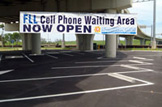 FLL introduced Pay-on-Foot and other automated parking payment programs designed to improve air quality by improving traffic flow, reducing congestion and thereby reducing vehicle emissions. Pay on Foot machines are conveniently located in the terminal exit areas or parking garages so that fees can be paid prior to exiting.
FLL introduced Pay-on-Foot and other automated parking payment programs designed to improve air quality by improving traffic flow, reducing congestion and thereby reducing vehicle emissions. Pay on Foot machines are conveniently located in the terminal exit areas or parking garages so that fees can be paid prior to exiting.
FLL’s cell phone lot, located alongside the parking garage under the airport’s access roadway system, accommodates up to 70 vehicles. Monitors provide timely information on flight arrivals. Since this facility opened, FLL has prohibited shoulder idling and idling in the cell phone lot, thereby reducing emissions and traffic hazards on highway shoulders and airport curbsides.
Traffic and Pedastrian Signal Conversions
The Traffic Engineering Division implemented the Green Lights Program to retime an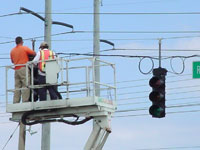 d coordinate the traffic signals along major traffic corridors throughout the County. The retiming of the major east/west corridors and University Drive, has resulted in less vehicles stopping unnecessarily at red lights, which eliminated approximately 300,000 metric tons per year of greenhouse gas emissions, and in saved approximately $14,400,000 per year in fuel cost among drivers. Additional reductions will be achieved when the retiming of the major north/south corridors gets underway.
d coordinate the traffic signals along major traffic corridors throughout the County. The retiming of the major east/west corridors and University Drive, has resulted in less vehicles stopping unnecessarily at red lights, which eliminated approximately 300,000 metric tons per year of greenhouse gas emissions, and in saved approximately $14,400,000 per year in fuel cost among drivers. Additional reductions will be achieved when the retiming of the major north/south corridors gets underway.
The Division also replaced approximately 26,000 red and green incandescent traffic signals that utilize 135 watts, with light emitting diode traffic signals at 12 watts each; and approximately 5500 incandescent pedestrian signals that utilize 90 watts, with LED pedestrian signals at 6 watts each, which produced approximately $1,223,000 in annual electrical savings.
County Fuel Conservation Measures
Parks and Recreation Division staff uses a four-passenger electric GEM cart to patrol Topeekeegee Yugnee (T.Y.) Park and to transport concession staff. Routes or zones are established for employees working “in the field” to reduce cross-county driving. As part of the County's initiatives to reduce its carbon footprint, improve air quality and achieve operating budget savings by eliminating unnecessary fuel consumption, a policy has been implemented to limit idle time to no more than five minutes on all motorized County-owned vehicles and equipment.
